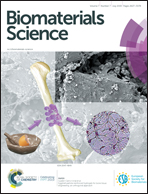Cell-penetrating peptide together with PEG-modified mesostructured silica nanoparticles promotes mucous permeation and oral delivery of therapeutic proteins and peptides†
Abstract
Poor permeation across intestinal mucous barriers often limits the oral delivery of prospective therapeutic proteins and peptides (TPPs). In order to address this issue, cell penetrating peptide (CPP) together with PEG modified and pore-enlarged mesostructured silica nanoparticle (NP) were constructed to form the mucus-penetrating electrostatic particle-complexes, CPP/TPP/NP. Alone, CPP and TPP often present with poor stability, and their traditional electrostatic complex shows reduced pharmacodynamics. To provide satisfactory protection, silica NPs were loaded with CPP and TPP (CPP@NP and TPP@NP), respectively, and then CPP@NP and TPP@NP could together form CPP/TPP/NP via electrostatic interaction. As a result, CPP involvement with PEG modification showed an 8.45-, 1.62- and 5.09-fold increase in cellular uptake, exocytosis and final transcellular permeation in mucous conditions, respectively. It was found that CPP involvement mainly affected transport and exocytosis, and the PEG polymer significantly influenced mucous penetration and cellular uptake, which could further promote CPP ability for uptake and exocytosis. Additionally, NP-mediated CPP/TPP/NP showed a similar uptake mechanism with supporting carriers (clathrin-mediated endocytosis), and could strengthen transcellular routes (the endoplasmic reticulum–Golgi apparatus pathway and the lysosome route). Utilizing recombinant growth hormone (RGH) as a model TPP, oral administration of the RGH-loaded CPP/TPP/LMSN-PEG10k with hydrophilic and electroneutral properties induced 5.41- and 4.91-fold increases in pharmacodynamics in vitro and in vivo, respectively. Thus, CPP/TPP/NP significantly promoted mucous permeation and shows promising potential for oral delivery of TPPs.



 Please wait while we load your content...
Please wait while we load your content...